I get a fair amount of e-mail from Jeepers that pass through my web site and drop a note to inquire or comment about something. Such was the case when I received an e-mail from Allen McKay, the man that runs Ramco Performance Manufacturing.
In his e-mail, Allen wrote “I own a company called Ramco Performance Manufacturing. We manufacture fuel filtration systems for the hi performance and racing industries. We are also a direct OEM supplier and private label for some of the largest engine builders in the world. Our products are used in drag racing, circle track, high performance marine, street rods etc.”
Allen had recently bought an early model used TJ (which explains how he ended up on my site). He had installed one of his company’s fuel filter systems and was surprised at the amount of particulates the TJ pump/filter had passed along to his filter. Logically, if his TJ was doing it, other TJs were probably doing it too. After an informative phone call with Allen, I agreed to do a product review using the same filter system he had installed, the FloMax 300.
A local Jeeper, DonP, has plans to do the Baja next year. Across the border gas being what it is, Don’s Rubicon was an excellent candidate for the filter installation. Before someone asks why this didn’t go on my TJ, I considered doing it but the two locations I really wanted to use as possible mounting locations were both taken up by the two auto tranny coolers that went in during last year’s AW4 installation. Besides that, I’ve no plans for running the Baja…..not yet. <grin> Besides that, wrenchin’ at Don’s house is pretty good….he provides great pizza and beer for lunch.
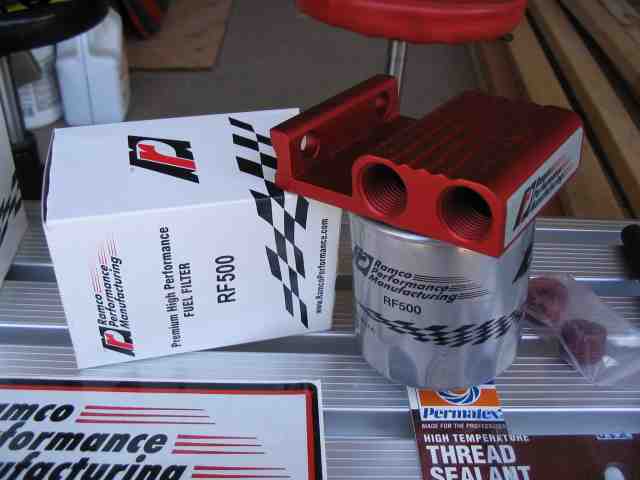
The filter removes particulates, as small as 5 microns, from the fuel stream. In addition to this, it also separates the water. The system uses a spin on filter and mounts in a fairly small 4″ tall space. The filter housing is made from billet aluminum. Designed to flow up to 300 gallons per hour (remember, it can be used on drag race engines too), you won’t suffer a fuel starvation problem with this in your TJ’s fuel line. The filter can be used on both suction or pressurized fuel delivery systems. The installation instructions suggest using it on the suction side of the pump, when possible. Since the TJ’s fuel pump is in the tank, we would certainly be able to detect any sealing issues once it was installed and the engine started.
One nice feature of the filter housing is the thought put into the mounting method. On Don’s TJ, we used 3/8″ bolts to mount it to a flat surface. The housing is also designed to accommodate mounting on a tube chassis, such as a rock buggy. The back of the mounting surface is shaped to fit the round tube and two slots are machined into the housing to allow for the hose clamps. When I showed the filter assembly to Troy, he gave it a very close once over and thanked me for it…..seems he thought it would go very well on the new rock buggy that he is building (yeah, I finally was able to get it back but not without a fight!) Troy likes to work with aluminum. He indicated that the housing was cleanly constructed and that it reflected good workmanship.
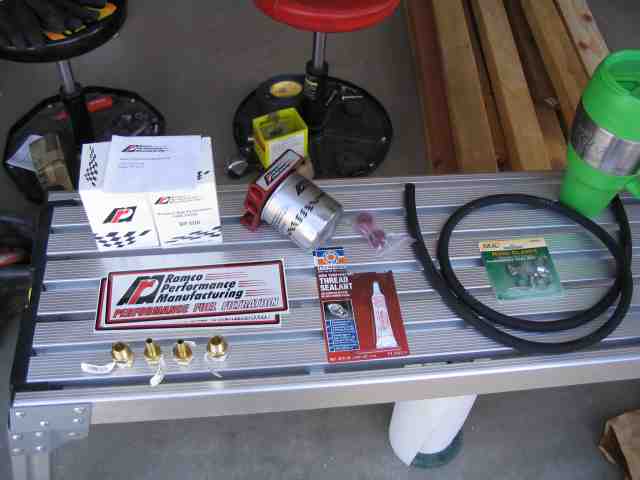
At the appointed time (plus some delays on Loop 101), I arrived at Don’s house to help with the installation and take the pictures. Don and I had previously discussed the install and necessary items needed to do the job. It was our goal to not make a trip to the hardware store once we got started. As it was, we were sitting pretty good. Don had already picked up a small tube of Permatex Thread Sealant, some 5/16″ fuel line, and a package of suitably sized hose clamps.
NOTE: At the suggestion of a couple of readers, I’m adding some additional info in regards to the fuel line. The TJ’s fuel pump operates in the vicinity of 50 PSI. As such, don’t try to cut corners and get the cheap fuel line. Spend a couple of extra dollars (literally) and purchase some quality fuel/emission line that is rated for a minimum of 50 PSI working pressure or better (having a little extra safety margin is a good thing).
I brought along a pair of 1/2″NPT male x 3/8″NPT male couplers and a pair of 3/8″NPT female x 5/16″ hose barb fittings. I tried to find 1/2″NPT x 5/16″ hose barbs, but the ACE store I was at didn’t carry them.
A drill motor and drill bit (for the mounting bolts) and a couple of wrenches for screwing in the adapters are required. You’ll also need an allen wrench to screw the two supplied plugs into the filter housing. The housing comes with two inlet and two outlet ports, allowing for the installation of a pressure gauge, drain valve, or any other component you may wish to add to the fuel system. If these are not used, the supplied plugs are used to fill the two extra ports.

In the above photo, the 1/2″NPT male x 3/8″NPT female bushings have been installed in both the inlet and outlet ports. Don has a couple drops of thread sealant on one of the plugs and is in the process of screwing it into the filter housing.
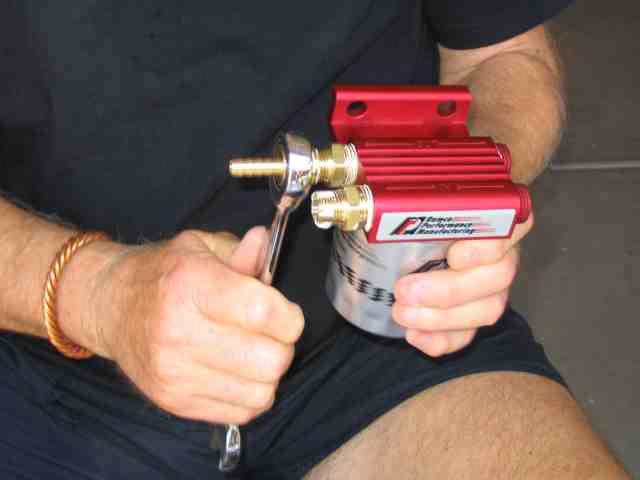
With both of the extra ports now plugged, Don turns his attention to threading in the 3/8″NPT male x 5/16″ hose barb fitting. Again, a couple drops of thread sealant are applied to the threads prior to screwing them into the housing.
FloMax 300 Fuel Filtration System

Don had purchased 4′ of fuel line. With it cut into two equal lengths, the line was attached to the hose bards and a hose clamp used to secure it in place.

Since this was Don’s Rubicon, it was his choice as to where the filter would get mounted. Obviously, it requires a relatively protected area, out of harms way and away from the trail obstacles.
Don decided to mount it to the floor of the tub on the driver’s side. Looking at the above photo, this spot is the rear edge of where the driver’s side back seat passenger would have there feet parked. There is a slight indentation from the factory and it was in this spot that we drilled a pair of mounting holes.
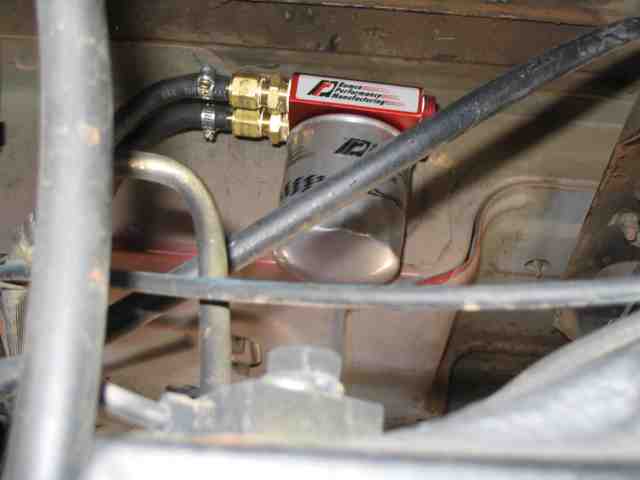
Before you bolt the filter housing in place, be sure to make a note of which hose is the IN and which is the OUT. Once you have the filter housing mounted, you won’t be able to see the marking on the top of the housing. Just in case you forgot to look, the OUT hose is located closest to the housing’s mounting holes.
Two holes later, along with a couple of 3/8″ mounting bolts, the filter housing was secured to the tub. Don and I both agreed that this was a pretty good mounting location. When it is time to replace the filter, it will be easy to access while making a minimal amount of mess.
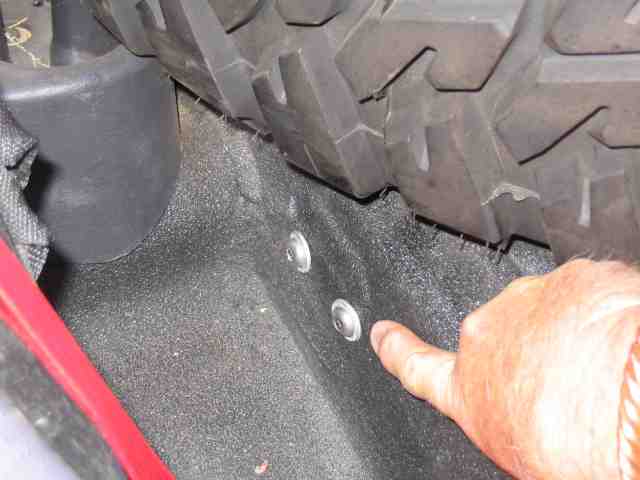
Here is a pic of the two button head mounting bolts that Don used for the filter housing. The button heads are not likely to snag any gear that Don will have in this area. In case you are wondering, Don has his tub lined.
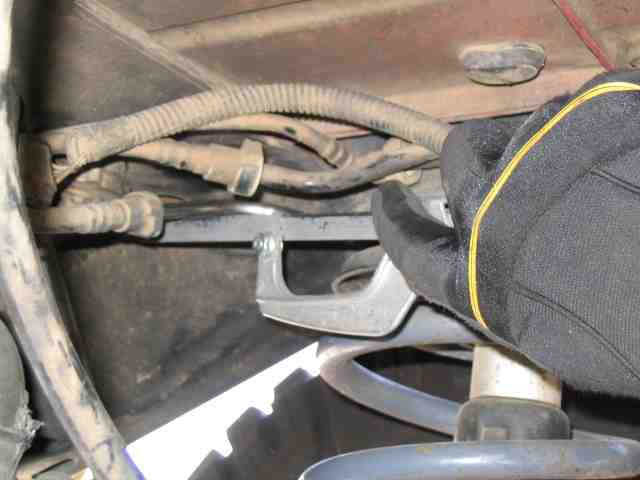
With the filter housing mounted, it was time to cut the gas line and splice the rubber fuel line onto the factory metal line. Suffice it to say that Don and I took our time in correctly identifying the gas line (there are three of them that look quite a bit alike) and deciding on the optimal location for making the cut. That old saying….”Measure twice, cut once” certainly applies in this situation. We both independently traced the fuel line from the engine’s injector rail back to the gas tank.
When we both were in agreement about which line required cutting, Don made the decision as to where that cut should be made. He selected a point very close to where the metal fuel transitions into the rubber hose that terminates at the fuel tank. There is a coupling that can be taken apart to separate the line from the gas tank….and it was just behind that coupling that Don cut the metal fuel line. He used a hacksaw, the style that has the blade protruding out of the end of the holder that made it much easier to get to the fuel line.
FloMax 300 Fuel Filtration System
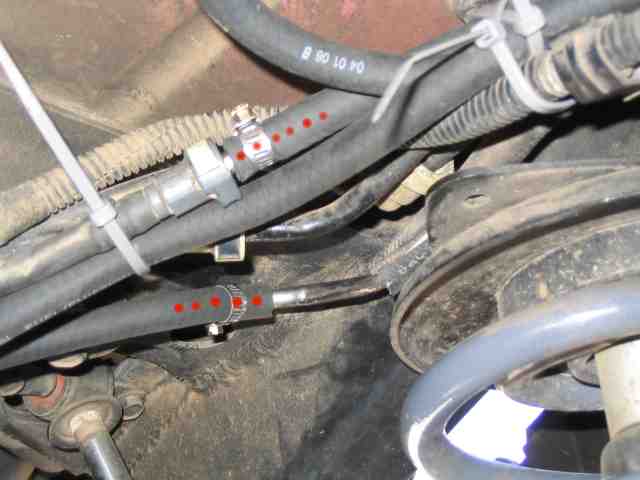
Once Don was finished with the hacksaw, I grabbed a small metal file and cleaned off the burrs from the cutting. Don then slipped the 5/16″ fuel line over both ends of the just cut fuel line. In the above pic, the rubber hoses with the red dots (and hose clamps) on them are the lines that Don secured to the factory metal fuel line. A couple of zip ties keeps everything up and out of the way. As Don mentioned, you don’t want the fuel hose flopping around and getting caught up in the vehicle’s suspension components.
NOTE: A local Jeepin’ friend of mine, BradW (who has appeared in a write-up or two), sent me an e-mail and said that he prefers to flair the end of the metal tube to help ensure the hose staying in place. Brad builds mobile pressure washing trucks and routinely does this with the gas line used for the pump engine. He uses the end of a needle nose pliers, putting the end of the closed pliers into the metal tube and then gently opening the pliers to push open the metal line. He said it doesn’t take much of a flair to really make a difference.
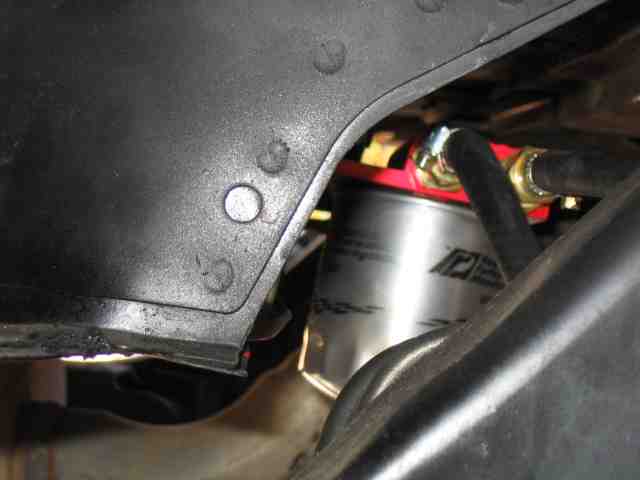
I snapped this pic (looking in from the driver’s rear tire fender well) of the installed filter assembly. It is indeed tucked up pretty well and sits out of the way.
Wrenching time on this was about 2 hours, which included a nice break and ample time to take photos, etc. You’ll probably need a friend during the install as holding the bolts in place (from inside the vehicle) while you hold the filter housing under the vehicle is a challenge for just one person.
It is my intention to pay another visit to Don’s place after he has had a chance to run up some mileage on the filter. I plan to open the filter and see what it looks like inside. When I do, I’ll do an update to this write-up for all to see.
So….if you are looking for a better fuel filtration and water separator setup for your vehicle, this may be just what the doctor ordered. For $69, the price is right and the quality is worth it, in my opinion. Get in touch with Ramco Performance Manufacturing and they will set you up.
Remember to TREAD Lightly!
Update: While we wait for Don to put a few thousand miles on his Rubicon before we open the fuel filter, I got hold of a couple of photos that came from Allen’s ’97 TJ. These photos were taken after the filter accumulated 2138 miles of drive time.
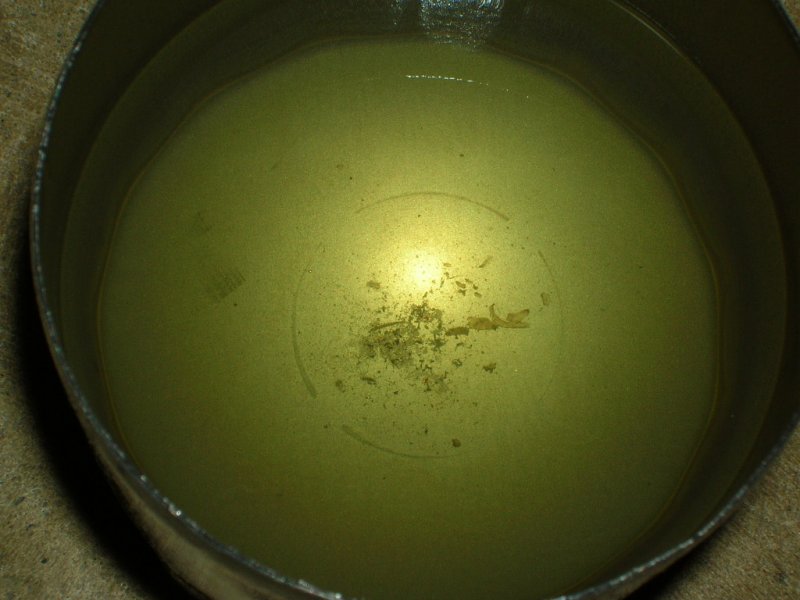
Allen’s comments in regards to the photo…..
“The attached photos show crud after 2138 miles. It appears as a mixture of fuel scum, grit etc. The debris which is evident is only in the filter canister and does not show what would be contained in the filter media and filter plate. Also the fuel in the filter canister has a very slight “cloudiness” which indicates moisture (I run a 10% ethanol blend at all times) in the fuel.”
During our e-mail exchange, Allen mentioned that the only thing stopping this stuff is the screens in the fuel injectors. Kind of makes you wonder if folks that have replaced their injectors did so earlier than necessary just because of dirty gas? I would have thought the TJ stock fuel filter would have done a better job than this.
FloMax 300 Fuel Filtration System
I got home from work today to find an e-mail from Don. He had sent a PM last week and said he was getting ready to change the FloMax filter. He promised me some photos and comments and in his e-mail was a short write-up and some photos. I’ve included several of the photos here along with his comments about the filter. I’ve known Don for a few years now. He is a guy that calls them like he sees them. If something’s good, he tell you it is. If something’s bad, he won’t hold back on that either. I respect Don’s opinion much more than I do most folks.
Don wrote….
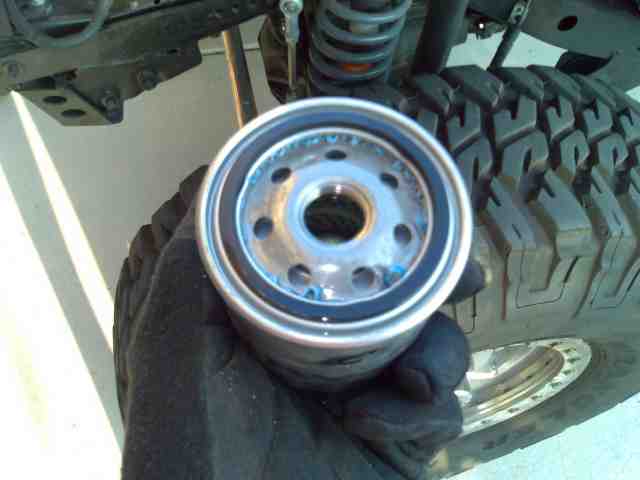
After about 3 months and 3k miles it was time to crack open the fuel filter and see if it was doing its job. Now we all know that the TJs have a fuel filter in the tank along with the fuel-sending unit so this will truly be a good test of the worthiness of the product.
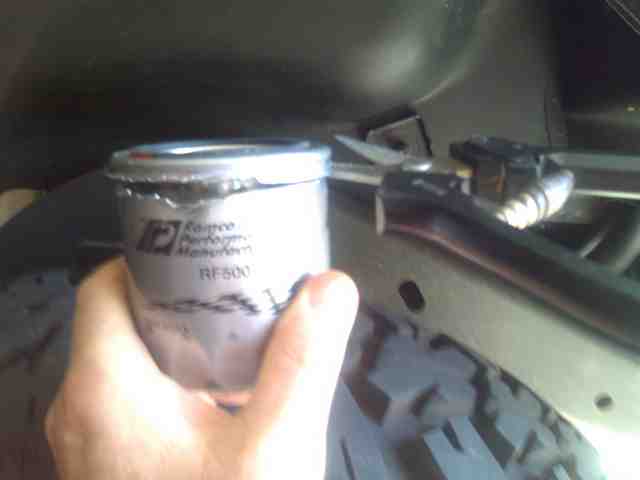
Getting it open without contaminating or mixing metal bits and possibly paint with the contents was the first problem. I first punched a hole in it with a metal punch, and then using a pair of snips, I opened it around the top and peeled the top back.

Then was able to remove the filter assembly. I used a sharp knife to circumvention cut in the center of the paper element to be better able to shake out any contaminates. Then I turned over the container and tapped it on the piece of white paper.
At first, I only saw a few very small dark pieces of contaminate. Very difficult to ascertain exactly what they might be (plastic, paint, metal, etc). As I ran my finger over them, I felt what I did not see, tiny particles of what felt like sand or grit. Now we are getting somewhere.
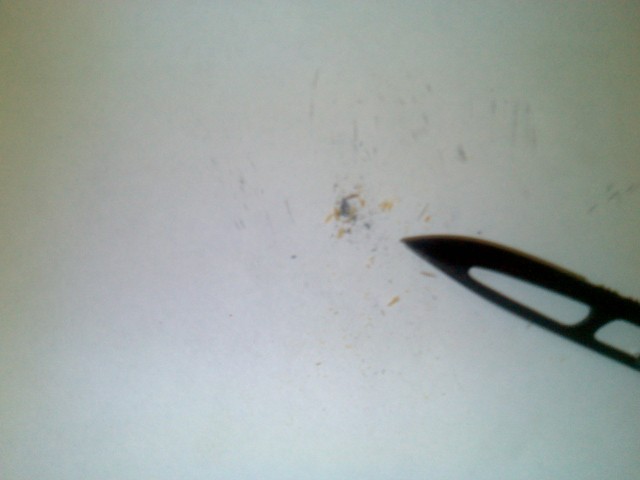
In the photo, you will see what appear to be small yellow-tan bits. This is some fluff from the cutting of the paper element and is very distinct.
Albeit may not appear to be a lot but I can assure you there is enough there to plug up every fuel injector you have.
Conclusion: This product warrants consideration by every Jeeper out there, whether it is a daily driver or a trail hound. The amount of contaminates captured in such a short time was clearly enough to cause a code and a light you don’t want to see on your dashboard.
